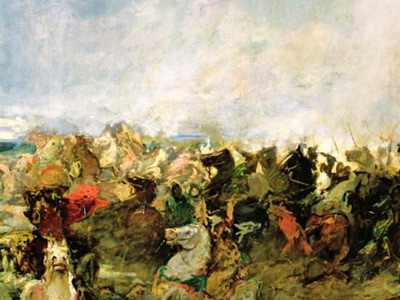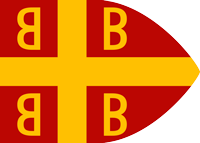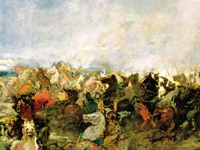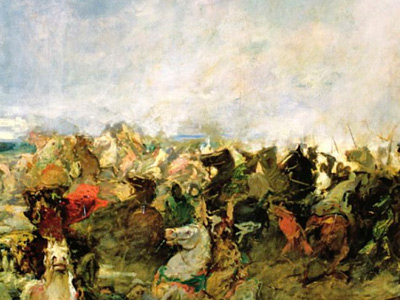Battle of Guadalete (711 AD)

The Battle of Guadalete was fought in 711 at an unidentified location between the Christian Visigoths of Hispania under their king, Roderic, and the invading forces of the Muslim Umayyad Caliphate, composed of Arabs and Berbers under the commander Ṭāriq ibn Ziyad. The battle was significant as the culmination of a series of Berber attacks and the beginning of the Umayyad conquest of Hispania. In the battle Roderic lost his life, along with many members of the Visigothic nobility, opening the way for the capture of the Visigothic capital of Toledo.
Background
Though the reign of Roderic is traditionally dated to 710–11, a literal reading of the Chronicle of 754 indicates 711–12. Roderic did not rule unopposed, however. The nature of his accession on the death of Wittiza from natural causes or through his assassination, is not clear from the sources. It is possible that Roderic was probably the dux (duke) of Baetica before coming to the throne. Archaeological evidence and two surviving lists of kings show that one Achila II ruled in the northeast of the kingdom at this time, but his relationship to Roderic is unknown. Probably they were rivals who never actually came into open conflict, due to the shortness of Roderic's reign and his preoccupation with Muslim raids. Even with Roderic's sphere of influence (the southwest) and his capital Toledo, he was not unopposed after his "usurpation" (the Chronicle of 754 calls it an "invasion").
The battle of Guadalete was not an isolated Berber attack but followed a series of raids across the straits of Gibraltar from North Africa which had resulted in the sack of several south Iberian towns. Berber forces had probably been harassing the peninsula by sea since the conquest of Tangiers in 705/6. Some later Arabic and Christian sources present an earlier raid by a certain Ṭārif in 710 and one, the Ad Sebastianum recension of the Chronicle of Alfonso III, refers to an Arab attack incited by Erwig during the reign of Wamba (672–80). and two reasonably large armies may have been in the south for a year before the decisive battle was fought. These were led by Ṭāriq ibn Ziyad, and others, under the overall command of Mūsā ibn Nuṣayr. Most of the Arabic and Berber accounts agree that Ṭāriq was a Berber military leader from northern Africa. Ignacio Olagüe, in La Revolución islámica en occidente, argues Ṭāriq to have been a Goth and the nominal governor of Tingitania. Others have argued that Ṭāriq was Jewish or Persian.
According to all sources, the earliest being Paul the Deacon, Ṭāriq left from Ceuta (Septem) and landed at the Rock of Calpe, the later Gibraltar, which Arabic sources derive from Jebel Tariq, "Rock of Ṭāriq". A legend first recorded by al-Idrīsī has it that Ṭāriq burned his boats after landing. From Gibraltar he moved to conquer the region of Algeciras and then followed the Roman road that led to Seville. According to Ibn ʻAbd al-Ḥakam writing around 860, Ṭāriq, commander of the Berber garrison of Tangiers, crossed the straits with ships from a certain Count Julian (Arabic Ilyan), lord of Ceuta and "Alchadra" (Algeciras), and landed near Cartagena, which he took and made his headquarters.
According to the Mozarabic Chronicle, Mūsā crossed the Gaditanum fretum (strait of Cádiz) with a large force in 711 and remained in Hispania for fifteen months, but it is unclear from the sources if he came before or after the battle of Guadalete, which was fought by the forces of his subordinates. During his time in the peninsula it was racked by civil war (intestino furore confligeratur, "internal frenzy", to the Mozarabic chronicler), cities were razed and many people slaughtered in the general destruction.
According to al-Maqqarī, Roderic was fighting the Basques when he was recalled to the south to deal with an invasion. There is also the record of a Byzantine The Byzantine Empire, also referred to as the Eastern Roman Empire or Byzantium, was the continuation of the Roman Empire primarily in its eastern provinces during Late Antiquity and the Middle Ages, when its capital city was Constantinople. It survived the fragmentation and fall of the Western Roman Empire in the 5th century AD and continued to exist for an additional thousand years until the fall of Constantinople to the Ottoman Empire in 1453. attack on southern Iberia that was repulsed by Theudimer some years before the fall of the Visigothic kingdom. This has led to theories that the Berber attacks may have been related to the Byzantine operation, and that perhaps the Arabs were originally useful allies in a Byzantine attempt to reconquer the lost province of Spania.
The Byzantine Empire, also referred to as the Eastern Roman Empire or Byzantium, was the continuation of the Roman Empire primarily in its eastern provinces during Late Antiquity and the Middle Ages, when its capital city was Constantinople. It survived the fragmentation and fall of the Western Roman Empire in the 5th century AD and continued to exist for an additional thousand years until the fall of Constantinople to the Ottoman Empire in 1453. attack on southern Iberia that was repulsed by Theudimer some years before the fall of the Visigothic kingdom. This has led to theories that the Berber attacks may have been related to the Byzantine operation, and that perhaps the Arabs were originally useful allies in a Byzantine attempt to reconquer the lost province of Spania.
The author of the late Asturian Chronica Prophetica (883) dates the first invasion of Spain to "the Ides of November in the year 752 era", that is, 11 November 714. He also identified two invasions, the first by an Abu Zubra and the second, a year later, by Ṭāriq; probably he has divided the historical figure Ṭāriq ibn Ziyad into two persons.
Engagement and Aftermath
The armies that met in battle on the day that decided the fate of the Gothic kingdom in Spain are not reliably described in the surviving records. Glick surmises that the Muslim army was predominantly Berber cavalry under Berber leadership. The Arabic sources traditionally give Roderic 100,000 troops, gathered during his return to the south after confronting the Basques. This number is outrageously high; it complements the figure of 187,000 for the Muslims provided by the Ad Sebastianum version of the Chronicle of Alfonso III. Ṭāriq is said to have landed with 7,000 horsemen and requested 5,000 more from Mūsā. There could thus have been as many as 12,000 Muslim fighters at the battle. One modern estimate, disregarding the primary source claims, suggest a quarter of the 7,500 reported in one of them; this would be approximately 2,000. The Visigothic forces were "probably not much larger", and the Visigothic kingdom was, unlike Francia to its north, not organized for war. A small number of elite clans (perhaps around twenty five), their warrior followings, the king and his personal following, and the forces that could be raised from the royal fisc constituted the troops upon which Roderic could draw.
The defeat of the Visigothic army followed on the flight of the king's opponents, who had only accompanied the host "in rivalry", "deceitfully", and "out of ambition to rule" says the Mozarabic chronicler. The story of Sisibert abandoning Roderic with the right wing of the host is a legend. Estimating Visigothic forces at 33,000, David Lewis recounts how the Muslim army engaged in a series of violent hit and run attacks, while the Visigothic lines maneuvered en masse. A cavalry wing that had secretly pledged to rebel against Roderic stood aside, giving the enemy an opening. Ṭāriq's cavalry, the mujaffafa, forming as much as a third of the total force and armored in coats of light mail and identifiable by a turban over a metal cap, exploited the opening and charged into the Visigothic infantry, soon followed by the infantry. The Christian army was routed and the king slain in the final hours of battle. The engagement was a bloodbath: Visigothic losses were extremely high, and the Muslims lost as many as 3,000 men, or a quarter of their force.
It is possible that his enemies intended to abandon Roderic on the field, to be defeated and killed by the Muslims. Whatever the case, their plan failed, for they too were largely slain. By another text from the Mozarabic Chronicle the treachery can be placed at Roderic's feet. He "lost his kingdom together with his patria with the killing of his rivals". This unclear passage could indicate that Roderic had killed his rivals and weakened his army, ensuring defeat, or that his rivals too died in the battle or its retreat. The chronicler may be blaming the defeat on factionalism. The Chronicle of Alfonso III, in both its versions, blames the anonymous "sons of Wittiza" for conspiring against Roderic. Oppa, Wittiza's historical brother, was found in Toledo, possibly as king-elect, by Mūsā when he took the city. This Oppa may have had a part to play in the opposition to Roderic, but certainly not his nephews, who would have been too young to participate in power politics in 711. The metropolitan of Toledo, Sindered, fled the city at the coming of the Muslims, and remained for the rest of his life an exile in Rome. The author of the Mozarabic Chronicle caustically notes that he was "an hireling, and not the shepherd" (quoting Jesus, Gospel of John 10:12). The Gothic nobleman Theudimer made an alliance with the conquerors to preserve his own rule of his territory. Within a decade all of the peninsula save the tiny Kingdom of Asturias and the mountain-dwelling Basques was under Muslims dominion and they had advanced beyond the Pyrenees as well.
The later Arabic historians universally credit their religion for the victory. Al-Maqqarī, in The Breath of Perfumes, places in the mouth of Ṭāriq a morale-boosting address to his soldiers on the eve of battle, which closes with this exhortation to kill Roderic:
Remember that I place myself in the front of this glorious charge which I exhort you to make. At the moment when the two armies meet hand to hand, you will see me, never doubt it, seeking out this Roderick, tyrant of his people, challenging him to combat, if God is willing. If I perish after this, I will have had at least the satisfaction of delivering you, and you will easily find among you an experienced hero, to whom you can confidently give the task of directing you. But should I fall before I reach to Roderick, redouble your ardor, force yourselves to the attack and achieve the conquest of this country, in depriving him of life. With him dead, his soldiers will no longer defy you.
According to later traditions, indigenous Iberian Jews, progressively disenfranchised under the rule of Christian monarchs and bishops, provided fighters to augment the Moorish forces. Kaula al-Yahudi distinguished himself in the battle at the head of a mixed contingent of Jews and Berbers, according to the compiler of the Akhbar Majmu'ah. In the aftermath of victory, the Jews reputedly took several cities and were even commissioned to garrison Seville, Córdoba, and Toledo itself. Thompson remarks that "whatever the reason for the [Goths'] persecution [of the Jews], it may have contributed to the utter destruction of those who initiated and enforced it." Despite all this, the participation of Jews on the side of the Muslims is not recorded in the Chronicle of 754.
The traditional explanation for the rapid fall of the Visigothic kingdom has been decadence. The late ninth-century Chronica Prophetica indeed blames the Goths' defeat on their lack of penance for their sins: "The city of Toledo, victor of all peoples, succombed as a victim to the triumphant Ishmaelites, and deserved to be subjected to them. Thus Spain was ruined for its disgusting sins, in the 380th year of the Goths." This is not accepted by specialists today, though it still exerts heavy influence through tertiary accounts, especially in Spanish-language historiography.
HISTORY

RESOURCES
This article uses material from the Wikipedia article "Battle of Guadalete (711 AD)", which is released under the Creative Commons Attribution-Share-Alike License 3.0.
© Stories Preschool. All Rights Reserved.









